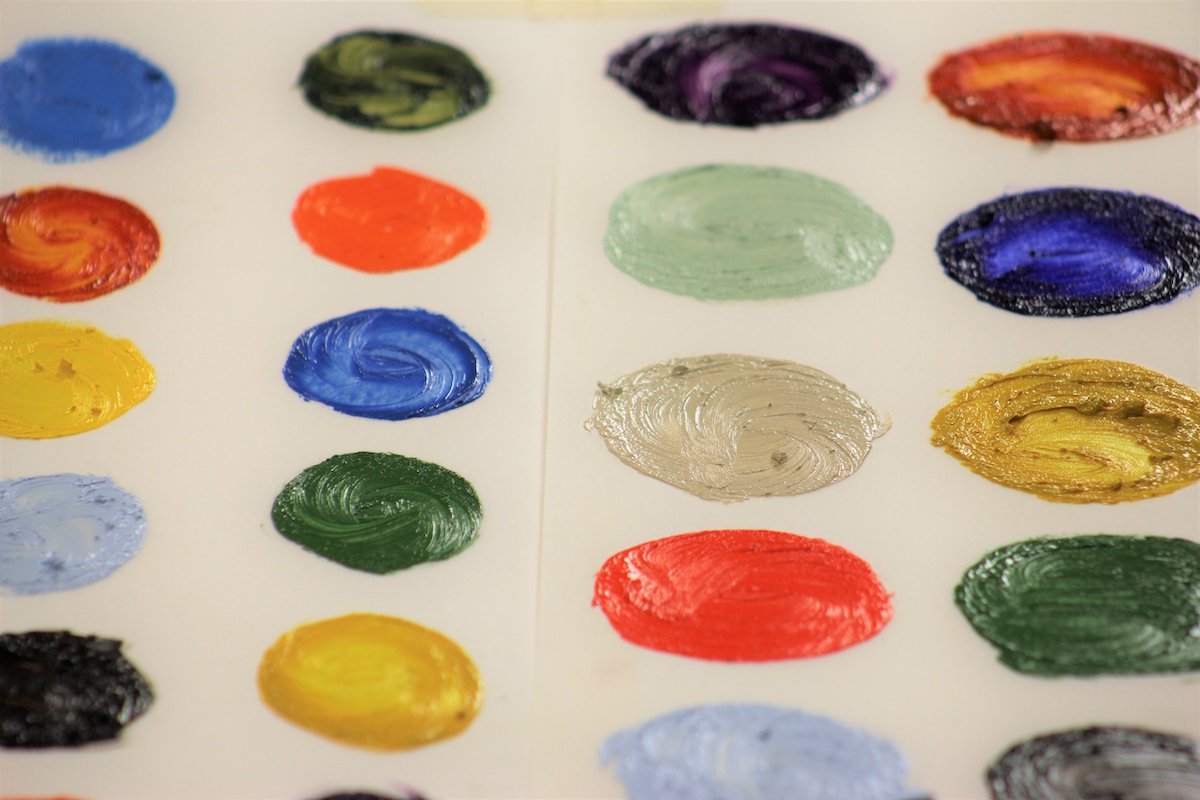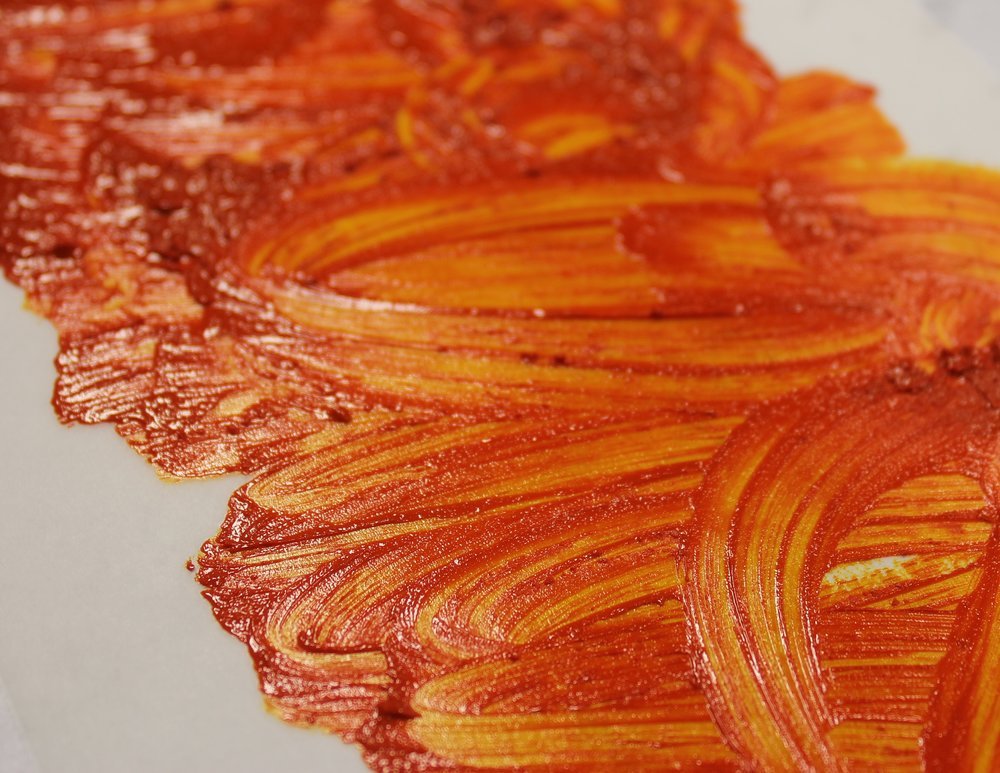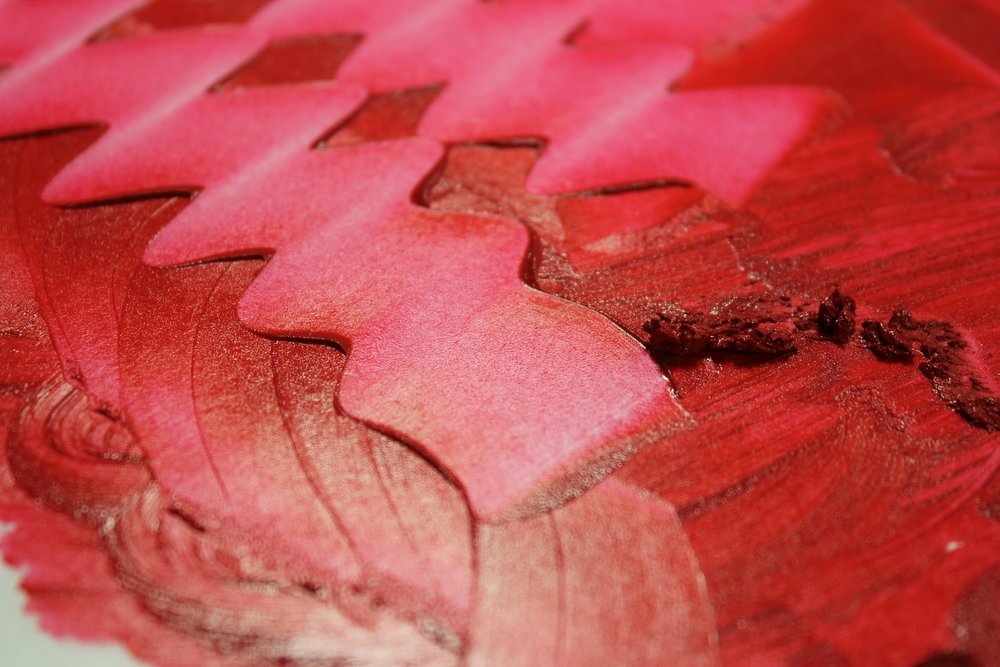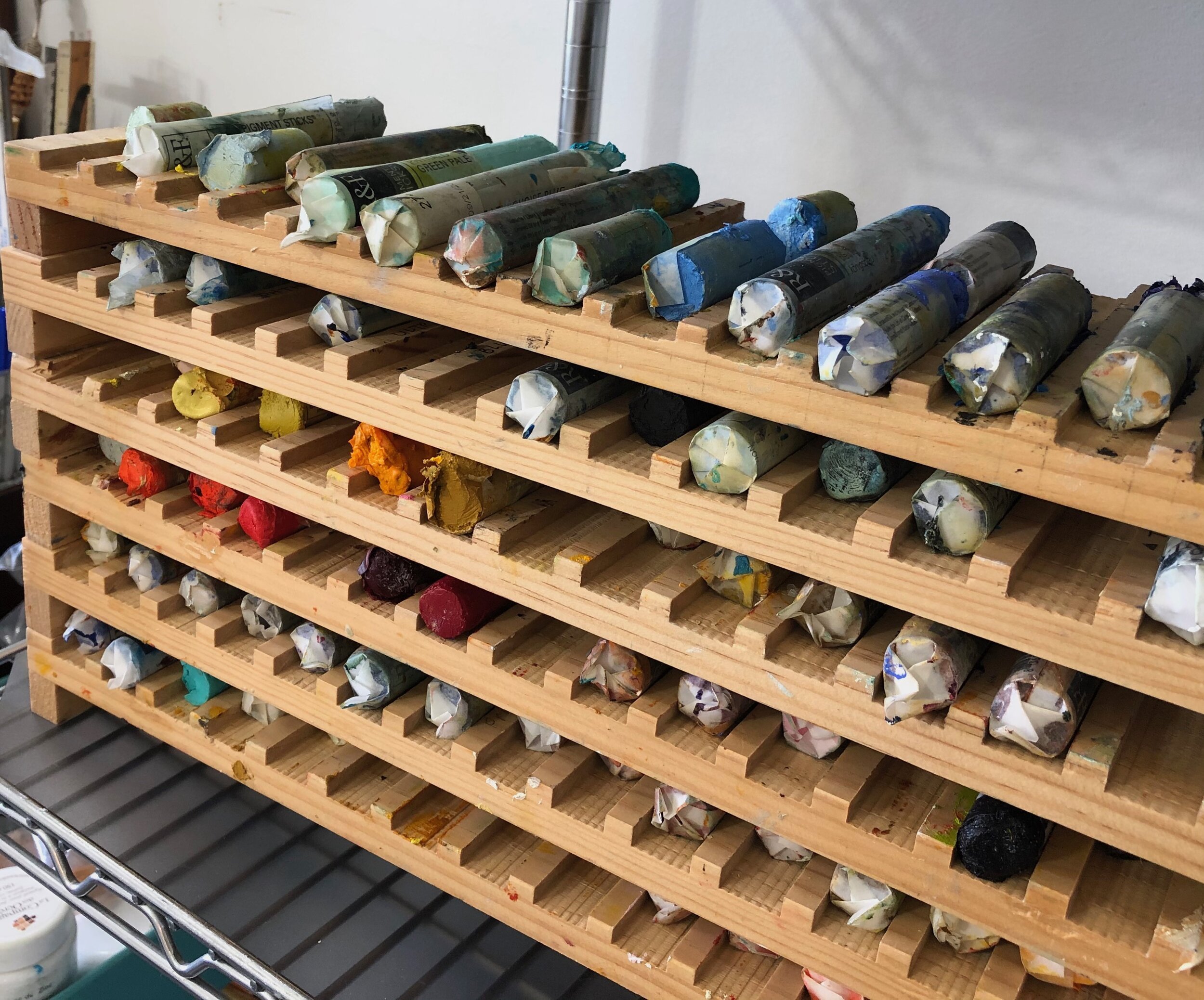Pigment Sticks: Your Top 5 Questions
Each week we receive dozens of questions about working with our paint lines - from how to store your paint, to drying times and varnishing. Below you will find info and links to help answer your top 5 burning questions on R&F Pigment Sticks®.
What are Pigment Sticks®, you ask? Pigment Sticks® are a high quality oil paint with just enough wax to be molded into stick form. They allow you to draw directly onto a surface without brushes, palettes, paint tubes, or solvents. R&F uses only the basic traditional materials: natural wax (beeswax and plant wax), linseed oil, and pigment. The result is an oil stick with a lipstick soft consistency.
R&F Pigment Sticks® have none of the additives, extenders, substitutes, or facilitators that are commonly used in industrial production. While the use of these adulterants can save time and reduce cost, they lower the quality of the paint. To do without them it is necessary to create a very precise balance of the ingredients. Our formulas are complex and our manufacturing is labor-intensive, handmade in small batches, carefully milled and molded.
How can you use Pigment Sticks®?
Pigment Sticks® are excellent as stand-alone painting and drawing tools. They enable artists to loosen up, be spontaneous and gestural. At the bottom of this blog post you will find a link to our YouTube channel, which has several helpful videos on working with Pigment Sticks®.
1. How long does it take for Pigment Sticks® to dry?
The number one question we get from folks who work with R&F Pigment Sticks® concerns their drying time. R&F Pigment Sticks® are made with linseed oil, wax, and pigment, but they dry as oil paint dries - which is to say, they oxidize. The oxygenated linseed oil forms long chains through a process called polymerization and becomes an irreversible, non-soluble film called linoxyn.
There are multiple factors that affect this drying process, which is referred to as “curing.”
Light is a factor. Drying in ambient light helps to speed up the drying time.
Temperature is also a factor. Paintings in warmer temperatures dry faster than those in cold temperatures.
Humidity plays a role. Low humidity will allow your paintings to dry faster than high humidity.
The substrate affects drying time. An absorbent substrate (such as Ampersand Encausticbord or Ampersand Gessobord) will enable your painting to dry faster, as it will soak up some of the oil.
Application impacts drying time as well. A thick layer will take longer to dry than a thin layer of Pigment Stick®.
And then, there’s the pigment itself. Some pigments grab oxygen faster than others. For example, our Raw Umber Pigment Stick® dries relatively fast because it contains manganese, which acts as a catalyst. Cobalt is also a faster drier. Cadmium is slower.
How can you tell whether a particular Pigment Stick® dries slower or faster? We categorize our Pigment Sticks® in terms of their drying speed as Very Slow, Slow, Medium, and Fast. You can find an index on the back of our Color Chart that shows you how each of our colors is categorized.
Download an R&F Color Chart here.
2. Can Pigment Sticks® be used with tube oil paint?
R&F Pigment Sticks® can be easily combined with tube oils. You can try this is by building up an abstract ground, or the general shapes, values, and contrast of a representational scene with a brush and tube oil paints. Once you have these forms established, apply Pigment Stick® to add layers. This could be the glimmering light in a plein-air scene, the heavier contrast of a still life, or visual textures easily achieved with our sticks.
You can also integrate oil painting mediums traditionally made for tube oil paints. Oil painting mediums have long been used to alter the state of oil paint, increasing transparency, speeding up drying times, and so on. You can use any of these mediums, varnishes, and solvents the same way you would with tube oil paints.
• Pigment Sticks® can be thinned with turpentine or mineral spirits.
• Pigment Sticks® can be worked with mediums by dipping them into stand oil, linseed oil, alkyd mediums, or resin gels.
• Pigment Sticks® can be mixed alongside tube oils, with Cold Wax Medium, or used to draw over dried oil paintings.
• Pigment Sticks® can be manipulated with a paint knife until the paint is a buttery consistency, so that it can be brushed or knifed onto the surface, or used to mix colors.
3. What is R&F Blending Medium with Drier? How is that different from R&F’s regular Blending Medium?
We describe our Blending Medium as “a Pigment Stick® without pigment.” It’s ideal for glazing colors. It can be worked directly into a color to increase the color’s transparency or used to blend colors together a surface.
Blending Medium with Drier is a version of our Blending Medium that contains a small amount of cobalt and manganese drier to help speed up drying times. The use of a drier can affect color, so the best use is to work colors on top of it after it has been laid down on the surface.
Blending Medium with or without drier comes in both a stick form (38ml., 100ml., and 188ml.) and in jars (8oz., 16oz., and 32oz.).
Image credit: R&F Core Instructor Julie Snidle.
4. How do I store Pigment Sticks®?
We are often asked for the best way to store Pigment Sticks®. As with many of the technical questions we receive, there tends to be more than one correct answer depending on your needs.
An excellent place to start is to ask yourself what exactly you would like out of your paint. Would you like all colors visible with quick access? Do you want to extend the life of the paint as long as possible? Should you separate by color family or opacity?
Placing R&F Pigment Sticks® into airtight containers slows the oxidation process and helps lengthen the life of the paint. Pigment Sticks® can also be left exposed to air if preferred. The outer layer of the paint will dry and skin over, protecting the inner material for an extended period of time. This may be ideal for very quick access to your paint, however, the dried paint skin will need to be removed with a rag and linseed oil.
Categorizing your paint is also a good idea. There are great benefits to separating colors by their opacity and color family. This will also help you discover the dynamic range of the top tone and undertone of each color, and how they relate when used together.
R&F Instructor Julie Snidle uses wooden stackable trays her dad built when she is painting. They work well for keeping the sticks separated, clean, and easy to label. When not painting, she stores her Pigment Sticks® in Ziploc bags, which are then stored in plastic bins with lids. Separate bags are used for new and used sticks. She groups them into categories including: Warm Transparent, Warm Opaque, Cool Transparent, Cool Opaque, and Neutrals and Metallics.
5. Does the rule of “fat over lean” apply when working with Pigment Sticks®?
Fat over lean is a rule of traditional oil painting whereby colors with high oil content should be laid over colors with low oil content. Lean colors are less flexible and can crack when applied over fat colors during the drying process. Fat colors can dry to a glossy surface that is difficult for another paint layer to adhere to.
Pigment Sticks® are oil paint, but with a percentage of wax. As oil paint, they too are subject to the rule of fat over lean. The wax, however, provides additional solid to the paint, which makes for some differences with oil paint from the tube. Wax gives the film a higher proportion of solid to oil. Because of this, the swelling and shrinking of the drying process is less than that of tube oil paint. While cracking can occur when a lean Pigment Stick® color is layered over a fat layer, it is less likely than with paint that has no wax in it.
Wax also makes Pigment Sticks® leaner than tube oil paint. Applying a continuous coat of Pigment Stick® over a dried thick coat that has been painted with tube oil paint is risky. Light drawing marks made over a dry surface are already more broken and less of a continuous film, therefore less likely to crack even if painted over a fat color.
It is safe to underpaint with Pigment Sticks® and overpaint with tube oil, especially if your underpainting is not very thick. If you have underpainted a thick coat with a fat color, however, you may need to fatten your tube oil paint to prevent cracking. The wax contained in the dried film of a Pigment Stick® lessens the formation of highly glossy surfaces that are hard to adhere to. If you are working wet into wet, even combining Pigment Stick® with tube oil paint, do not worry about fat over lean.
Download Fat Over Lean to learn more about working with Pigment Sticks®.
